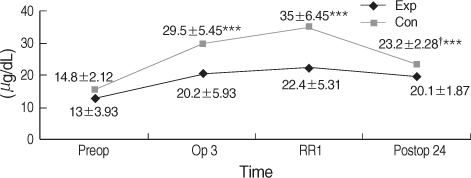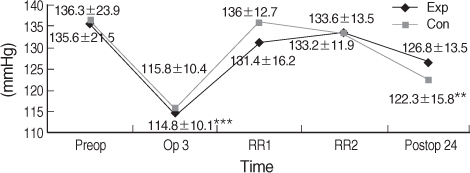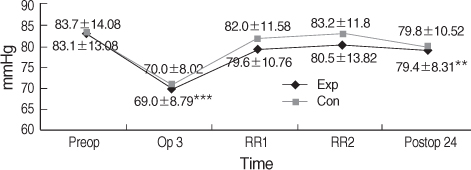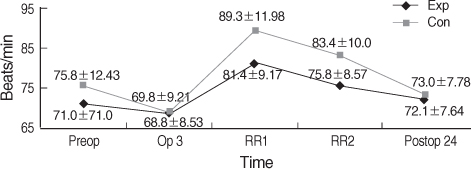J Korean Acad Nurs.
2008 Oct;38(5):720-729. 10.4040/jkan.2008.38.5.720.
The Effects of Preemptive Analgesia of Morphine and Ketorolac on Postoperative Pain, Cortisol, O2 Saturation and Heart Rate
- Affiliations
-
- 1Gil Medical Center, Incheon, Korea.
- 2Department of Nursing, Gachon University of Medicine & Science, Incheon, Korea. hsyoon@gachon.ac.kr
- KMID: 1125538
- DOI: http://doi.org/10.4040/jkan.2008.38.5.720
Abstract
-
PURPOSE: This study investigated the preemptive analgesic effects of Morphine and Ketorolac on postoperative pain, cortisol, O2 saturation and heart rate for the first 24 hr after abdominal surgery.
METHODS
Data collection was performed from April 1 to September 30, 2006. Forty patients undergoing a gastrectomy under general anesthesia were randomly allocated to the experimental or control group. The experimental group (20 patients) was administered Morphine and Ketorolac approximately 1 hr prior to skin incision, but the control group (20 patients) was administered Morphine and Ketorolac at peritoneum closure through a patient-controlled analgesia (PCA) pump. Postoperative pain, blood pressure, heart rate, cortisol, O2 saturation, frequency of the PCA button pressed and doses of additional analgesics were observed through post operative 24 hr. Collected data was analyzed using t-test, chi-square test, repeated measures ANOVA, and Bonferroni methods.
RESULTS
Postoperative pain, cortisol, the frequency of PCA button pressed, and dose of additional analgesics of the experimental group were significantly lower than the control group. There were no statistical differences in blood pressure, heart rate and O2 saturation between the experimental group and control group.
CONCLUSIONS
We concluded that administration of morphine and ketorolac at 1 hr prior to skin incision resulted in decreasing postoperative pain, but it didn't affect blood pressure, heart rate or O2 saturation for 24 hr after abdominal surgery.
MeSH Terms
Figure
Reference
-
1. Ahn EK, Yoon DM, Kim JH, Lee YW, Kim JR, Seouk MJ. Effect of preemptive analgesia on post-operative pain. Korean Journal of Anesthesiology. 1996. 30:479–486.2. Ashburn MA, Love G, Pace NL. Respiratory-related critical events with intravenous patient-controlled analgesia. Clinical Journal of Pain. 1994. 10:52–56.3. Aubrun F, Langeron O, Quesnel C, Coriat P, Riou B. Relationships between measurement of pain using visual analog score and morphine requirements during postoperative intravenous morphine titration. Anesthesiology. 2003. 98:1415–1421.4. Bai SJ, Nam SH, Lee YW, Nam YT, Kim WJ. The effect of preemptive intravenous ketorolac for total hip replacement patients. Korean Journal of Anesthesiology. 1998. 35:511–517.5. Cho GT, Sohn HJ, Kim SB, Shin YD, Bae JH, Kim ST, et al. The effect of the IV-PCA (Intravenous Patient Controlled Analgesia) on the recovery index. Korean Journal of Anesthesiology. 2001. 41:318–323.6. Collis R, Brandner B, Bromley LM, Woolf CJ. Is there any clinical advantage of increasing the pre-emptive dose of morphine or combining pre-incisional with postoperative morphine administration? British Journal of Anaesthesia. 1995. 74:396–399.7. Fiedler MA. Clinical implications of ketorolac for postoperative analgesia. Journal of Perianesthesia Nursing. 1997. 12:426–433.8. Filos KS, Vagianos CE. Pre-emptive analgesia: How important is it in clinical reality? European Surgical Research. 1999. 31:122–132.9. Fleming BM, Coombs DW. A survey of complications documented in a quality-control analysis of patient-controlled analgesia in the postoperative patient. Journal of Pain and Symptom Management. 1992. 7:463–469.10. Grass JA. Patient-controlled analgesia. Anesthesia and Analgesia. 2005. 101:S44–S61.11. Hagle ME, Lehr VT, Brubakken K, Shippee A. Respiratory depression in adult patients with intravenous patient-controlled analgesia. Orthopaedic Nursing. 2004. 23:18–27.12. Huh YJ, Jung CW, Joh JY, Kim YL. The effect of the initiating time of patient controlled analgesia on the onset of postoperative analgesic effect. Korean Journal of Anesthesiology. 2004. 47:101–105.13. Kaufman E, Epstein JB, Gorsky M, Jackson DL, Kadari A. Preemptive analgesia and local anesthesia as a supplement to general anesthesia: A review. Anesthesia Progress. 2005. 52:29–38.14. Kim HY, Yoon HS. The effects of ketamine preemptive analgesia on postoperative pain in patients undergoing hysterectomy. Journal of Korean Academy of Nursing. 2006. 36:114–126.15. Kim SJ, Oh SW, Park SG, Koo GH. The effects timing of connection with intravenous PCA. Chung-Ang Journal of Medicine. 1998. 23:145–153.16. Kissin I. Preemptive analgesia: Why its effect is not always obvious. Anesthesiology. 1996. 84:1015–1019.17. Kissin I. Preemptive analgesia. Anesthesiology. 2000. 93:1138–1143.18. Lee EO, Lim NY, Park HA. Nursing medical research and statistical analysis. 1998. Seoul: Soomoonsa.19. Marret E, Kurdi O, Zufferey P, Bonnet F. Effects of nonsteroidal antiinflammatory drugs on patient-controlled analgesia morphine side effects: Meta-analysis of randomized controlled trials. Anesthesiology. 2005. 102:1249–1260.20. Mansfield M, Meikle R, Miller C. A trial of pre-emptive analgesia. Influence of timing of peroperative alfentanil on postoperative pain and analgesic requirements. Anaesthesia. 1994. 49:1091–1093.21. Norman PH, Daley MD, Lindsey RW. Preemptive analgesic effects of ketorolac in ankle fracture surgery. Anesthesiology. 2001. 94:599–603.22. Ochroch EA, Mardini IA, Gottschalk A. What isthe role of NSAIDs in pre-emptive analgesia? Drugs. 2003. 63:2709–2723.23. Oh SW, Woo YC, Jung YH, Koo GH. Does pretreated NSAIDs decrease the postoperative consumption of morphine? Korean Journal of Anesthesiology. 1999. 36:462–468.24. Pasqualucci A, de Angelis V, Contardo R, Colò F, Terrosu G, Donini A, et al. Preemptive analgesia: Intraperitoneal local anesthetic in laparoscopic cholecystectomy. A randomized, double-blind, placebo-controlled study. Anesthesiology. 1996. 85:11–20.25. Parke TJ, Lowson SM, Uncles DR, Daughtery MO, Sitzman BT. Pre-emptive versus post-surgical administration of ketorolac for hysterectomy. European Journal of Anaesthesiology. 1995. 12:549–553.26. Rang HP, Dail MM, Rirrer JM, Moore EE. Pharmacology. 2003. 5th ed. New York, NY: Churchill Livingstone.27. ogers JE, Fleming BG, Macintosh KC, Johnson B, Morgan-Hughes JO. Effect of timing of ketorolac administration on patient-controlled opioid use. British Journal of Anaesthesia. 1995. 75:15–18.28. Sato C, Tanaka H, Kawamoto M, Yugo O, Ogawa R. Low oxygen saturation during early postoperative period in adult patients receiving opioids by intravenous patient-controlled analgesia. Masui. 2004. 53:659–663.29. Varrassi G, Panella L, Piroli A, Marinangeli F, Varrassi S, Wolman I, et al. The effects of perioperative ketorolac infusion on postoperative pain and endocrine-metabolic response. Anesthesia and Analgesia. 1994. 78:514–519.30. Vander AJ, Shermar JH, Luciano DS. Human physiology: The mechanisms of body function. 2004. 8th ed. New York, NY: McGraw-Hill Inc.31. Wall PD. The prevention of postoperative pain. Pain. 1988. 33:289–290.32. White PF. The changing role of non-opioid analgesic techniques in the management of postoperative pain. Anesthesia and Analgesia. 2005. 101:S5–S22.33. Woolf CJ, Chong MS. Preemptive analgesia-treating postoperative pain by preventing the establishment of central sensitization. Anesthesia and Analgesia. 1993. 77:362–379.
- Full Text Links
- Actions
-
Cited
- CITED
-
- Close
- Share
- Similar articles
-
- Balanced Analgesia with Morphine , Ketorolac and Droperidol in the Treatment of Postoperative Pain in the Gynecologic Patient
- The Effect of Preemptive Analgesia with Morphine, Ketorolac, Droperidol
- The Effects of Preemptive Intravenous Ketorolac for Total Hip Replacement Patients
- Analgesic Effect of Intraarticular Morphine or Ketorolac after Arhroscopic Knee Sugery
- The Effect of Continuous Infusion of Ketorolac on Morphine IV PCA







